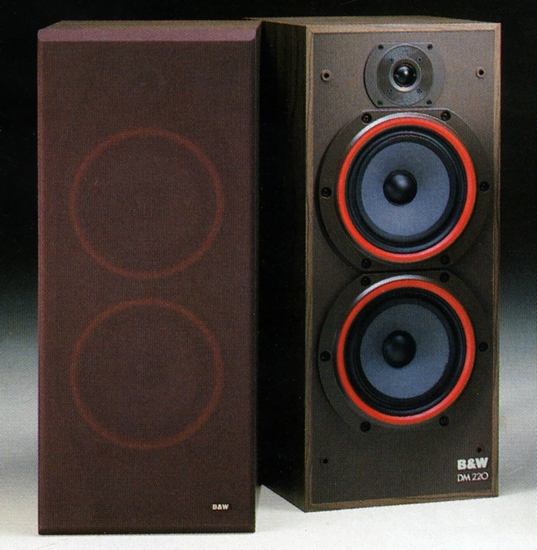
B&W DM220
¥ 69,800 (1 unit, around 1984)
Commentary
A bookshelf type speaker system developed as a new line of reference monitors.
In the development of DM 220 and DM 110, B & W has set the theme of providing excellent capabilities to completely clear various program sources.
For this reason, sensitivity and transient characteristics are improved in order to cope with the latest sources with a wide dynamic range, and wide and flat frequency characteristics are obtained by quality control equivalent to 801F.
In addition, by automating the manufacturing process of the driver unit and strictly controlling uniformity, the symmetry of the L/R channel is maintained.
Two 20 cm cone type woofers are mounted in the low range and drive the band of 500 Hz or less in parallel.
A fiber cone is used for the diaphragm, and high efficiency and excellent transient characteristics are obtained by driving with a strong magnetic circuit while aiming at low mass. In addition, in order to realize flat frequency characteristics, special processing is applied to each part of edge, cone paper and center cap, and zinc die cast is used for the unit frame to firmly hold the unit.
In addition, the roll-off characteristics of the unit itself match those of the secondary Butterworth filter, and by simply passing the secondary Butterworth filter through one stage, the characteristics of the fourth Butterworth filter (24dB/oct) are reasonably realized. This gives ideal slope characteristics, and by realizing steep attenuation characteristics at the crossover point, interference to the high range of the woofer is effectively suppressed.
A 2.6 cm soft dome type tweeter is installed in the high range.
The diaphragm is made of polyamide film, which has high internal loss and low high-frequency resonance, enabling natural and accurate high-frequency reproduction. Polyamide film is lightweight, highly sensitive, and easy to uniform unit characteristics in the manufacturing process.
Zinc die-cast is used for the frame as well as the woofer, and coupled with the newly developed strong magnetic circuit, it is linearly compatible with a source with high frequency energy.
In the network section, we have introduced the numerical optimization design technique established in the development stage of 801F. By combining the characteristic data of each unit and circuit constants, we simulate the operation of a crossover network on a computer display in pursuit of ideal connections.
We use carefully selected high-quality parts to prevent deterioration of sound quality.
A 15 mm thick high-density particle board is used for the enclosure, and a sealed system is adopted.
The exterior is designed by Kenneth Grange of the Pentagram Design Institute.
There are 2 variations, black finish and walnut finish, and the color of the woofer frame is different for each.
Model Rating
| Method | 3-Way, 3-Speaker, Airtight Type, Bookshelf Type |
| Unit | For low band : 20 cm cone type For middle and low band : 20 cm cone type For high-pass : 2.6 cm dome type |
| Frequency characteristic | 53 Hz to 20 kHz ± 3 db |
| Allowable input | 100W (suitable for amplifiers with an output of 10W or more) |
| Impedance | 8 Ω |
| Output sound pressure level | 90dB/W/m |
| Crossover frequency | 500 Hz, 3 kHz |
| External dimensions | Width 290x Height 680x Depth 320 mm |
| Weight | 15.1kg |
.jpg)
.jpg)
.jpg)
.jpg)